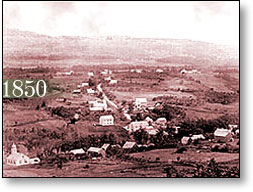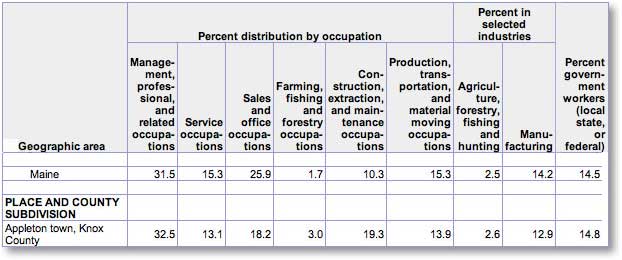"An old farm is always more than the people under its roof. It is the past as well as the present, and vanished generations have built themselves into it as well as left their footsteps in the worn woodwork of the stair."
...Henry Beston
"Northern Farm"
Appleton in the 19th Century
Appleton is the most northern town in Knox County. It is bounded on the south-east by Hope, on the south-west by Union, on the northwest by Liberty, in Waldo County, and north-east by Searsmont in that county. The Medomac and St. George's rivers run through the town. Sennebec Pond is the principal body of water, being two miles in length and one in width. Appleton Ridge - which has a height of about 300 feet - is the greatest elevation The ledges are generally of a brittle, gray rock. The soil on the uplands is generally rocky, and clayey in the valleys. Hemlock, spruce, beech and maple form the mass of the woods. The principal crops are corn, potatoes, wheat, oats and hay. Medomac River drains the western part and St. George's the eastern part of the town.
Villages and small towns depend on agriculture to sustain them. With other industries small and scattered, up to 80% of the land in some areas is devoted to growing crops to feed humans or livestock. Wool production expands dramatically (leaving stone walls crisscrossing Maine as reminders that persist today). Remaining forests are heavily used for firewood and lumber. In the northwoods, even some of the smallest streams are dammed and then released to float logs to downstream mills.
 At Appleton village are a grist mill, a lumber and stave mill, factories for the manufacture of carriages, hand-rakes, cultivators, leather, boots and shoes, etc. Some lime is produced for export at this place. At North Appleton are a lumber mill, lime quarry, etc. At North Union P. 0. is a lumber mill. The Appleton Mining and Smelting Company is an enterprise of this town. [Note: Click on the photo to enlarge... The subject property lies across and up-river (northward, to the right of the bridge) about 1/4 mile.]
At Appleton village are a grist mill, a lumber and stave mill, factories for the manufacture of carriages, hand-rakes, cultivators, leather, boots and shoes, etc. Some lime is produced for export at this place. At North Appleton are a lumber mill, lime quarry, etc. At North Union P. 0. is a lumber mill. The Appleton Mining and Smelting Company is an enterprise of this town. [Note: Click on the photo to enlarge... The subject property lies across and up-river (northward, to the right of the bridge) about 1/4 mile.]
The inhabitants are generally thrifty, and most of the buildings are in good repair. In the village some of the streets are pleasantly shaded with trees; many of the elms being upward of forty years of age. The climate is salubrious, and the town boasts a number of inhabitants upwards of ninety years of age. The longest bridge in the town is about 120 feet in length. It is of wood, with stone abutments. The principal public entertainments are Temperance Reform Club meetings. These, when supplemented by some literary exercises, become more generally useful and improving; and the increased variety sustains the interest for many seasons in succession.
 The Methodist and Baptists each have a church edifice in town. Appleton has ten public schoolhouses, which, together with other school property, are valued at $4,950. The valuation of estates in 1870 was $284,278. In 1880 it was $320,664. The rate of taxation in 1880 was 2-1/2 per cent. The population in 1870 was 1,485; in 1880 it was 1,348. [Note: Click on the photo to enlarge... The southern pastures and fields of the subject property are beyond the church spire, and run to the river.]
The Methodist and Baptists each have a church edifice in town. Appleton has ten public schoolhouses, which, together with other school property, are valued at $4,950. The valuation of estates in 1870 was $284,278. In 1880 it was $320,664. The rate of taxation in 1880 was 2-1/2 per cent. The population in 1870 was 1,485; in 1880 it was 1,348. [Note: Click on the photo to enlarge... The southern pastures and fields of the subject property are beyond the church spire, and run to the river.]
In the 20th Century
From 1860 to 1940, farming declines - Beginning around the time of the Civil War, several factors - the migration of Maine veterans, the rise of industry, the opening of better land in the American Midwest, and the Great Depression, cause many Maine farms to be abandoned. Young forests quickly take over, though the types of trees are not always the same as what existed before a century or more of farming. Most elms are gone from Appleton.
In the 20th Century
Until the late 1970's, the subject property was operated by Joseph Moody as a dairy farm, and many now-grown residents remember their occasional youthful employment, haying the Moody's fields, stacking hay to the rafters of both barns, and, in the fall, splitting and putting away the 10 cords of fire wood that got that family through the winter. Joe Moody's wife, Esther, was an Appleton school teacher, and is still remembered for her strict ways. In 2005, the fields yielded approximately 700 square bales of hay, but the sanitary concrete "milkroom," installed in the 1950's with much grumbling about new and expensive regulations by the State, has since been converted to a sauna; vestigal milking equipment remains in the eastern stalls of the attached barn.
Occupations in 2000




